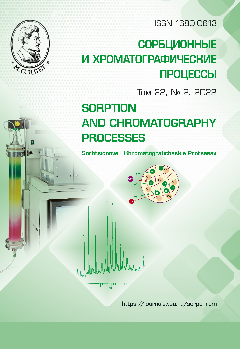Сравнение эффективности извлечения америция и плутония на твердофазных экстрагентах ТОДГА, DN Resin-B и TEVA Resin-B из модельных пульп накопленных высокоактивных отхо-дов
Abstract
The study is devoted to the development of a technology for the separation of accumulated higher activity waste (HAW) of a complex composition of americium and plutonium radionuclides from dissolved sediments for their removal into a separate stream for vitrification. Such a solution will make it possible to harden the remaining solution, containing the main amount of macrocomponents, by a simpler and more accessible method of cementing. For the provision of the possibility of cementing of dissolved pulps accumulated by HAW, it is necessary to achieve the following purification factors from the main alpha-emitting radionuclides: for americium ~ 300, for plutonium ~ 150. The content of uranium in dissolved pulps does not limit the degree of inclusion of this solution in the cement compound. For the simulation of the presence of americium and plutonium in the solution, their chemical analogues, Nd and Th, respectively, were used in the experiments.
The efficiency of combined extraction of neodymium and thorium from a model solution simulating dissolved sediments of accumulated higher activity waste was studied using solid-phase extractants of domestic and foreign production based on N,N,N',N'-tetraoctyldiglycolamide (TODGA and DN RESIN-B). For the selective extraction of thorium, solid phase extraction based on the quaternary ammonium base TEVA Resin-B was used. The possibility of achieving the required purification coefficients was shown.
According to the efficiency of sorption on TFE DN Resin-B and TODGA, the components of the solution can be arranged in the following order: Th>Nd>U.
A two-stage scheme was tested with preliminary separation of thorium on a solid-phase extractant TEVA RESIN-B and subsequent extraction of neodymium on a solid-phase extractant DN Resin-B. It was established that the preliminary separation of thorium allows increasing the efficiency of neodymium removal by 3 times. However, the efficiency of thorium recovery by solid phase extraction using TEVA Resin-B SPE was lower than for TODGA and DN Resin-B SPE. Therefore, the scheme with two successive stages of purification on SPE DN Resin-B is more preferable.
The reduction of the uranium content in the model solution from 3.2 g/dm3 up to 0.9 mg/dm3 allowed significantly increasing the efficiency of extraction of neodymium and thorium.
Downloads
References
Logunov M.V., Karpov V.I., Dru-zhinina N.E. Approaches to Reprocessing of Highly Radioactive Sludge Accumulated at the Mayak PA.Voprosy radiacionnoj be-zopasnosti. 2011; 1: 15-28. (In Russ.)
Kozlov P.V., Remizov M.B., Makarovskij R.A. Main Approaches, Prac-tices and Challenges Faced at Reprocessing of Liquid Radioactive Waste with Complex Chemical Composition Stored in Vessels. Radioaktivnye othody. 2018; 4(5): 55-66. (In Russ.)
Postanovlenie pravitel’stva no. 1069 ot 19.10.2012.
Turanov A.N., Karadashev V.K. Re-covery of Rare-Earth Elements From Nitric Acid Solutions Using Polymer Sorbent Im-pregnated With Diphenyl (Dialkyl Car-bamoyl Methyl) Phosphine Oxides. Radio-himija. 2002; 44(6): 506-511. (In Russ.)
Miljutin V.V., Gelis V.M. Sorption of Ions of REE(III), Th(IV) and U(VI) from Nitric Acid Solutions Using Tetraoctyl Di-glycolamide-Based Sorbents. Radiohimija. 2015; 57(5): 438-441.
Ansari S.A., Pathak P.N. N, N, N’, N’,–Tetraoctyl Diglycolamide (TODGA): A Promising Extractant for Actinide-Partitioning from High-Level Waste (HLW). Solv. Extr. Ion Exch. 2005; 23(4): 463-479.
Chuhlanceva E.V., Sergeeva N.L. De-termination of Americium Macroquantities Using Tetraoctyl Diglycolamide Impregnat-ed Sorbent for Subsequent Spectral Deter-mination of Impurities in Americium Diox-ide. Analitika I kontrol’. 2012; 16(2): 143-150. (In Russ.)







